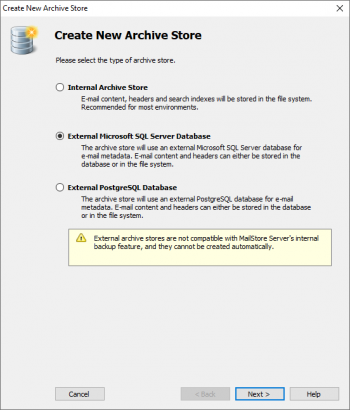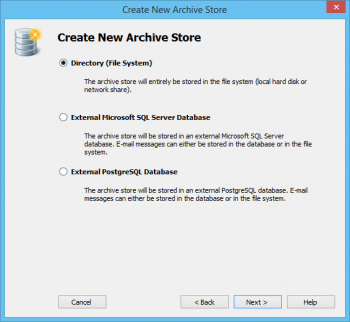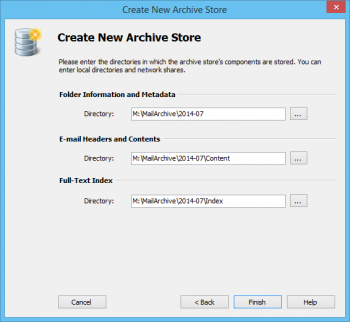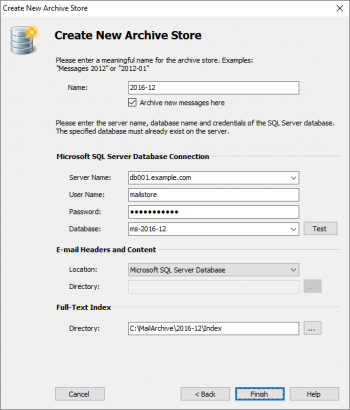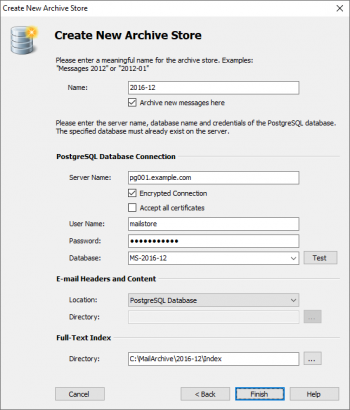Difference between revisions of "Using External Archive Stores"
| [unchecked revision] | [unchecked revision] |
| Line 68: | Line 68: | ||
*: '''User Name:''' Name of the user with access to the database. | *: '''User Name:''' Name of the user with access to the database. | ||
*: '''Password:''' Password of the user listed under ''User Name''. | *: '''Password:''' Password of the user listed under ''User Name''. | ||
| − | *: '''Database:''' Name of the database to be used by MailStore. Click on the arrow to the right of the input field to obtain a list of all available databases | + | *: '''Database:''' Name of the database to be used by MailStore. Click on the arrow to the right of the input field to obtain a list of all available databases on the server. |
| − | * Under ''email headers and contents'' select the appropriate storage location.<br/><br/>''Microsoft SQL Server Database'' is the default suggestion. When choosing ''Directory (File System)'', the input field ''Directory'' is activated. MailStore proposes a directory based on the name entered at the beginning of the wizard and the path of the master database. To choose a different directory, click on the button next to the ''Directory'' field or enter a path manually.<br/><br/> '''Important Notice:''' The specified directory is created automatically. If it already exists, it must not contain any | + | * Under ''email headers and contents'' select the appropriate storage location.<br/><br/>''Microsoft SQL Server Database'' is the default suggestion. When choosing ''Directory (File System)'', the input field ''Directory'' is activated. MailStore proposes a directory based on the name entered at the beginning of the wizard and the path of the master database. To choose a different directory, click on the button next to the ''Directory'' field or enter a path manually.<br/><br/> '''Important Notice:''' The specified directory is created automatically. If it already exists, it must not contain any fields of subfolders. |
* A directory for the full text index is also recommended based on the name entered at the beginning and the path of the master database. | * A directory for the full text index is also recommended based on the name entered at the beginning and the path of the master database. | ||
* Click on ''Finish''. | * Click on ''Finish''. | ||
Revision as of 03:40, 2 May 2012
MailStore distinguishes between two types of archive stores: Standard archive store and advanced archive store.
When using standard archive stores, folder information, meta data, email headers and contents, as well as the full text index are stored within a directory structure in the file system, while advanced archive stores allow you to store these components in different locations, such as SQL databases, for example.
For most environments, using standard archive stores is recommended, which is described in detail in chapter Storage Locations.
Structure of an Archive Store
In MailStore, both standard an advanced archive stores always consist of the following three components:
- Folder Information and Meta Data
- Contains all data needed for the construction of the directory structure and the email list, which in some cases is also used in search requests.
- Email Headers and Contents
- Contains the actual payload of the archive.
- Full Text Index
- Contains all data needed for browsing emails and attachments.
While there is a direct relationship between folder information and meta data and email headers and contents, the full text index is derived from both and can be reconstructed at any time.
Because of its special data structure and for performant access, the full text index must always be stored in the file system. Using MailStore's local file system is recommended. Additional information about full text indexes is available in chapter Search Indexes.
Creating an Advanced Archive Store
To create an advanced archive store, please proceed as follows:
- Start MailStore Client and log on as MailStore administrator (admin).
- Click on Administrative Tools > Storage and then on Storage Locations.
- In the menu bar at the bottom of the window click on Create....
- The dialog Create new archive store opens.
- Enter a name for the new advanced archive store into the Name field, e.g. 2012-05.
Please note: If you don't want MailStore to archive new emails in the new archive store, remove the checkmark from the box titled Archive new messages here. - Select Advanced Archive Store and click on Next.
- Select the type of advanced archive store:
- Directory (File System)
The entire archive store is stored in the file system (local hard drive or network share). - External Microsoft SQL Server Database
The archive store is stored in an external Microsoft SQL Server Database. Emails can be stored in the database or in the file system. - External PostgreSQL Database
The archive store is stored in an external PostgreSQL Database. E-Mails can be stored in the database or in the file system.
- Click on Next.
Depending on the type selected, different input is required. How each archive store type is configured is described in the following sections.
Advanced Archive Store Type: Directory (File System)
Using an advanced archive store of type Directory (File System) requires you to specify directories for the Folder Information and Meta Data, the Email Headers and Contents and the Full Text Index.
Based on the name entered at the beginning of the wizard and the path of the master database MailStore suggests the directories of the new advanced archive store. To change a proposed path, click on the respective button next to the directory field or enter a path manually.
Important Notice: The directories are created automatically. If they already exist, they must not contain any files of subfolders.
Please note that distributing the individual components of an advanced archive store among local drives or network shares significantly increases the complexity of Backup and Restore.
Advanced Archive Store: External Microsoft SQL Server Database
Before you can set up the database connection in MailStore, an empty database has to be created on the database server. The MailStore user who is used for the connection should be the owner of the database. Please see the documentation of the database server for details.
Folder information and meta data are always stored in the SQL database, while storing email headers and contents therein is optional.
Please note: MailStore supports all editions of Microsoft SQL Server Version 2005, 2008 and 2012. Please keep their respective size limits in mind and verify their suitability for managing the expected volume of data in your environment.
Once an empty database has been created, please proceed as follows:
- Specify the connection parameters for the Microsoft SQL Server Database Connection:
- Server Name: Enter the server name or the IP address of the SQL server on which a database has been created for MailStore. If you click on the arrow to the right of the input field, MailStore will return a list of all Microsoft SQL servers located on the network.
- User Name: Name of the user with access to the database.
- Password: Password of the user listed under User Name.
- Database: Name of the database to be used by MailStore. Click on the arrow to the right of the input field to obtain a list of all available databases on the server.
- Under email headers and contents select the appropriate storage location.
Microsoft SQL Server Database is the default suggestion. When choosing Directory (File System), the input field Directory is activated. MailStore proposes a directory based on the name entered at the beginning of the wizard and the path of the master database. To choose a different directory, click on the button next to the Directory field or enter a path manually.
Important Notice: The specified directory is created automatically. If it already exists, it must not contain any fields of subfolders. - A directory for the full text index is also recommended based on the name entered at the beginning and the path of the master database.
- Click on Finish.
Please note that distributing the individual components of an advanced archive store among different local drives or network shares significantly increases the complexity of Backup and Restore.
Advanced Archive Store: External PostgreSQL Database
Bevor Sie die Datenbankverbindung in MailStore einrichten können, müssen Sie auf dem Datenbankserver eine leere Datenbank erstellen. Der Benutzer den Sie beabsichtigen in MailStore zur Verbindung zu verwenden, sollte Besitzer der Datenbank sein. Die genaue Vorgehensweise entnehmen Sie bitte der Dokumentation des Datenbankserver.
In der SQL-Datenbank werden bei diesem Archivspeichertyp immer die Ordnerinformationen und Metadaten abgelegt und optional auch die E-Mail-Kopfzeilen und -inhalte.
Hinweis: MailStore unterstützt PostgreSQL ab Version 8.4.8 oder neuer.
Nachdem Sie eine leere Datenbank angelegt haben, fahren Sie wie folgt fort:
- Legen Sie die Verbindungsparametern für die PostgresSQL-Datenbankverbindung fest:
- Servername: Tragen Sie den Servernamen oder IP-Adresse des SQL Servers ein, auf welchem Sie eine Datenbank für die Verwendung von MailStore erstellt haben.
- Benutzername: Benutzername mit Zugriff auf die Datenbank.
- Kennwort: Das Passwort der unter Benutzername angegebenen Benutzers.
- Datenbank: Name der Datenbank welche MailStore verwenden soll. Klicken Sie auf den Pfeil an der rechten Seite des Eingabefeldes um eine Liste der zur Verfügung stehenden Datenbanken des Servers abzurufen.
- Wählen Sie unter E-Mail-Kopfzeilen und -inhalte den gewünschten Speicherort aus.
Standardmäßig wird PostgresSQL-Datenbank vorgeschlagen. Wenn Sie Verzeichnis (Dateisystem) auswählen, aktiviert sich das Eingabefeld Verzeichnis. MailStore erstellt aus dem eingegebenen Namen zu Beginn des Assistenten und dem Pfad der Masterdatenbank einen Vorschlag für das Verzeichnis. Klicken Sie auf die Schaltfläche hinter dem Feld Verzeichnis oder tragen Sie manuell einen Pfad ein um ein anderes Verzeichnis zu verwenden.
Wichtiger Hinweis: Das angegebene Verzeichnis wird automatisch angelegt. Falls es bereits existiert, dürfen sich darin keine Dateien und Unterverzeichnisse befinden. - Das Verzeichnis für den Volltextindex wird von MailStore ebenfalls anhand des zu Beginn eingegebenen Namens und dem Pfad zu Masterdatenbank vorgeschlagen.
- Zum Fertigstellen klicken Sie auf Fertig.
Bitte beachten Sie, dass das Verteilen der einzelnen Bestandteile eines erweiterten Archivspeichers auf verschiedene lokale Laufwerke oder Netzwerk-Shares die Komplexität der Datensicherung und Wiederherstellung deutlich erhöht.
